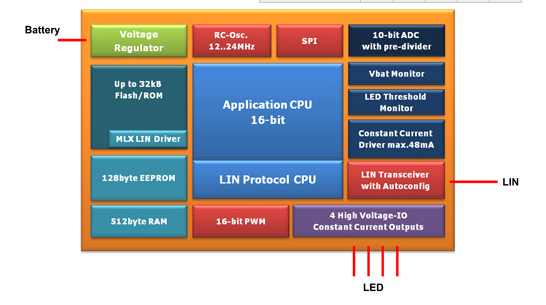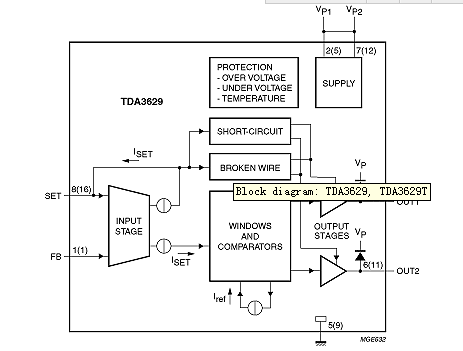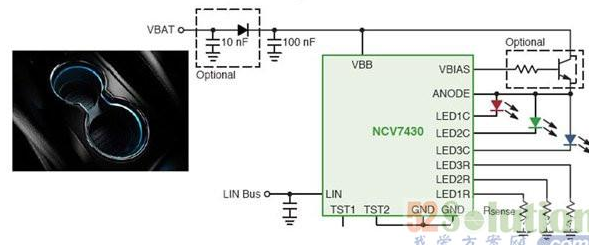Providing a better driving experience, car lighting is absolutely indispensable. Although the automotive ambient light illumination system has introduced red, green and blue light-emitting diodes (RGB LEDs), there are still problems such as design complexity and high cost. In order to meet the requirements of different automotive lighting applications, a new generation of integrated regional interconnect network (LIN) interface RGB can solve this problem. It can achieve LED light source control through the existing in-car LIN network, and can greatly simplify the design of ambient light lighting system while reducing overall development costs.
LIN control features and functions
In view of the primary goal of controlling the implementation cost of ambient light lighting systems, the Regional Interconnect Network (LIN) has become a way to control the array of ambient light lighting system LED lights, which has the advantage of using existing automotive communication facilities. The lightweight, single-wire LIN bus can complement the high-performance, but expensive, control area network (CAN) for communication. Because each RGB LED module can be connected to the LIN network, no need to add car wiring, the result is that the cost of the entire system can be kept to a minimum, and the overall weight of the vehicle does not increase, thus avoiding an increase in fuel consumption. And if the current point-to-point wired array is used, it is bound to increase fuel consumption.
Automotive manufacturers are looking for a cost-effective way to implement ambient light lighting systems. To meet this market demand, industry vendors have introduced highly integrated, freely programmable LIN RGB LED slave interface integrated circuits (ICs). ), it has a built-in constant current source that can directly drive up to four LEDs (red, green, blue and extra white).

LIN RGB LED Slave Interface IC Functional Block Diagram
In addition, RGB ambient light modules can be interconnected via the vehicle's LIN system, eliminating the need for lengthy development processes or extensive engineering resources. From a development perspective, this advanced technology is undoubtedly a big benefit for automakers. Through more attractive and entertaining ambient lighting functions, the car can be made more personalized, stand out from competitive products, and more Importantly, this feature will no longer be limited to high-end cars, but will work for all cars.
Two car lighting solutions PK
1.NXP lighting solution
The UJA1018 from NXP Semiconductors is a compact, integrated solution that supports flexible and cost-effective automotive LED ambient lighting applications. Designed for LIN networks (local interconnect networks), the UJA1018 is the first ASSP (Application Specific Standard) for ambient lighting with node position detection. It enables individual programming of the LIN address of the LED module after it is installed in the vehicle, rather than programming during module manufacture.

Automotive interior lighting block diagram
NXP's superior automotive technology platform and products enable a highly integrated solution that delivers full functionality to drive LEDs in a variety of configurations, simplifying LED lead-in design, minimizing the number of low-cost external components and smaller package sizes.
LED driver
The ASL10xxNTK and ASL10xxPHN are a family of fully integrated LED drivers for automotive lighting applications. The temperature feedback of the ASL1002NTK and ASL1004NT drivers controls the temperature and performance of the LEDs. LED fault detection provides feedback when an LED fails. It also provides short-circuit protection of the system to the battery and ground, external current selection and PWM programming, internal PWM generation of the dimming LED, and eliminates LED ripple current, eliminating the need for external components.
Light level controller
The light position controller (Leucht Weiten Steller, LWS) is a monolithic integrated circuit designed for vehicles. The device adjusts the height of the headlight beam of the car according to the state determined by the driver of the vehicle using the potentiometer on the dashboard. The TDA3629 and TDA1629T light level controllers feature low positioning error and low noise sensitivity. In addition, the TDA3629 and TDA1629T have low supply current and can be thermally protected. The SET input has a disconnection and short-circuit indication, which can provide a disconnection function through a short circuit of the motor.

Display function block diagram
2. Ansonmei Lighting Solutions
1) Internal RGB LED lighting solution
The Local Interconnect Network (LIN) bus is a low-cost serial communication protocol used in today's automotive network architectures. The NCV7430 LIN RGB LED driver combines a LIN transceiver with RGB LED drivers and memory for automotive interior lighting. This single-chip RGB driver monitors dedicated multi-color LED applications in automotive interior lighting.
The NCV7430 includes a LIN interface (slave) for LED color and light intensity parameter settings. The device receives instructions via the LIN bus and then drives the LEDs independently. The NCV7430 acts as a slave on the LIN bus, and the master can read specific status information (parameter values ​​and error flags) over the bus. The LIN address of the NCV7430 can be programmed through the internal memory of the device.

Automotive interior lighting solutions
Features of the NCV7430 also include protection and diagnostics for overcurrent detection (ground and VBB short circuit detection, LED open circuit detection, high temperature warning and retry mode when shutdown and detection of errors); power saving (sleep mode supply current 20 mA, compatible with 14 V Automotive systems); and EMI compatibility (LIN bus integrated ramp control, LED modulation mode reduces EMC).
2) External and internal lighting constant current regulator (CCR) solution
The Double-Ended Linear Constant Current Regulator (CCR) is a simple, economical, and rugged device that provides an effective current-stabilization solution for cost-sensitive LED applications for automotive exterior lighting such as central high-position brake lights (CHMSL) and internal Lighting, such as cockpit lights, vanity mirror lights, glove boxes. The device does not require external components and can be used as a high-side or low-side current regulator to regulate the output current over a wide input voltage range. It is designed with a negative temperature coefficient to protect the LED from extreme voltage and operation. Protected from thermal runaway under conditions.
The current-sense currents of the NSI45xxx, NSI50xxx, NSIC20xx, NSI45xxxJ, and NSI50150AD devices provide constant brightness over a wide voltage range; the negative temperature coefficient protects the LEDs at high ambient temperatures; and is available in a variety of maximum voltage versions (45 V, 50 V and 120 V) to withstand battery voltage sags.

Constant current stabilizer for automotive interior and exterior lighting
In addition to the above solutions, ON Semiconductor also offers other LED driver solutions. The compact 350 mA step-down LED driver CAV4201 and CAT4201 feature a patented average current stabilizing architecture that can drive up to seven LEDs in series with a 24 V supply to handle transient voltages up to 40 V with energy efficiency greater than 94%. Limited current and overheat protection, LED open circuit protection. Its car version CAV4201 has passed AEC-Q100 certification. Another multi-topology constant current switching regulator, the NCV3065 for high-brightness LEDs, has a drive current of 1.5 A. It uses an external switch to boost energy efficiency, supports PWM and analog dimming, and can withstand transient voltages up to 40 V.
DMX512 Digital LED Strip is a programmable led strip, be controlled by the international standard DMX512 protocol, which is addressable and programmable
by using the external drive chip DMX512.Compatible with and extend DMX512 (1990) signal protocol, the control mode is differential parallel,
built-in 485 decoding module, strong anti-interference ability, low-voltage DC24V,very safer for users.
Supports the operation mode of first installing and writing code later, and can realize any animation effect of the product through controller programming.
Suitable for large engineering projects.
DMX512 Digital LED Strip
High CRI LED Strip,Outdoor LED Strip Light,DMX RGB LED Strip,DMX512 Digital LED Strip
SHEN ZHEN SEL LIGHTING CO.,LTD , https://www.sel-lighting.com